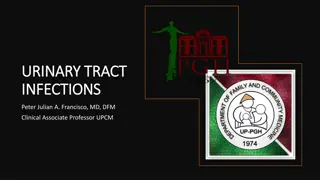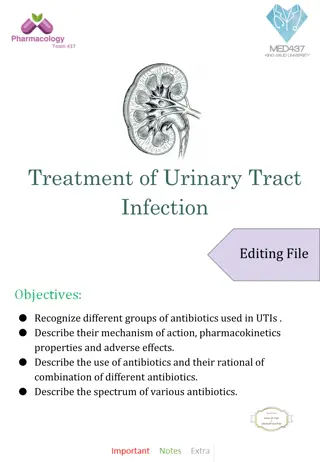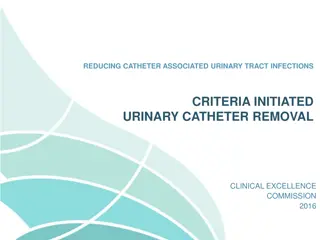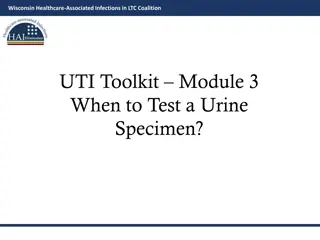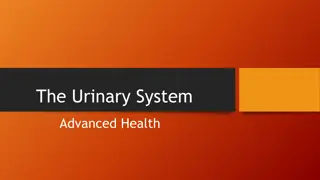Urinary Tract Infections and Risk Factors
A urinary tract infection (UTI) involves the urinary tract, causing symptoms like painful urination, frequent urge to urinate, and more. Factors like sexual activity, catheterization, and anatomical abnormalities contribute to UTIs. Bacteria usually enter via the urethra, and differentiating factors include cervicitis, vaginitis, and interstitial cystitis. Medications like nitrofurantoin and trimethoprim/sulfamethoxazole are commonly prescribed for recurrent UTIs.
Download Presentation

Please find below an Image/Link to download the presentation.
The content on the website is provided AS IS for your information and personal use only. It may not be sold, licensed, or shared on other websites without obtaining consent from the author.If you encounter any issues during the download, it is possible that the publisher has removed the file from their server.
You are allowed to download the files provided on this website for personal or commercial use, subject to the condition that they are used lawfully. All files are the property of their respective owners.
The content on the website is provided AS IS for your information and personal use only. It may not be sold, licensed, or shared on other websites without obtaining consent from the author.
E N D
Presentation Transcript
Facultad de Ciencias Medicas de Sagua la grande DEPARTAMENTO DE IDIOMAS DEPARTAMENTO DE IDIOMAS ASIGNATURA: INGLES IX ASIGNATURA: INGLES IX- -X X
Professors: Professors: Lic. Jessie Sarduy Santana. Assistant Professor.(jessiess@infomed.cu) Cell phone :54250473 Lic. Elizabeth Finalet Marreros. Auxilliary Professor. (elizabetfm@infomed.cu) Cell phone: 59289393 Objective:To describe the main features of Urinary Tract Infections associated to the Urologist Ward.
A urinary tract infection (UTI) is an infection that affects part of the urinary tract. When it affects the lower urinary tract it is known as a simple cystitis and when it affects the upper urinary tract it is known as pyelonephritis . Symptoms from a lower urinary tract include painful urination and either frequent urination or urge to urinate (or both), while those of pyelonephritis include fever and flank pain in addition to the symptoms of a lower UTI. In the elderly and the very young, symptoms may be vague or non specific. The main causal agent of both types is Escherichia coli, however other bacteria, viruses or fungi may rarely be the cause.
In young sexually active women, sexual activity is the cause of 75 90% of bladder infections, with the risk of infection related to the frequency of sex. Urinary catheterization increases the risk for urinary tract infections. The risk of bacteriuria (bacteria in the urine) is between three to six percent per day and prophylactic antibiotics are not effective in decreasing symptomatic infections. A predisposition for bladder infections may run in families. Other risk factors include diabetes, being uncircumcised, and having a large prostate. Complicating factors predisposing anatomic, functional, or metabolic abnormalities. are rather vague and include
Pathogenesis The bacteria that cause urinary tract infections typically enter the bladder via the urethra. However, infection may also occur via the blood or lymph. It is believed that the bacteria are usually transmitted to the urethra from the bowel, with females at greater risk due to their anatomy Differential Diagnosis With cervicitis (inflammation of the cervix) or vaginitis (inflammation of the vagina) and in young men with UTI symptoms, a Chlamydia trachomatis or Neisseria gonorrheae infection may be the cause. Vaginitis may also be due to a yeast infection. Interstitial cystitis (chronic pain in the bladder) may be considered for people who experience multiple episodes of UTI symptoms but urine cultures remain negative and not improved with antibiotics. Prostatitis (inflammation of the prostate) may also be considered in the differential diagnosis.
Medications For those with recurrent infections, a prolonged course of daily antibiotics is effective. Medications frequently used include nitrofurantoin and trimethoprim/sulfamethoxazole. Methenamine is another agent frequently used for this purpose as in the bladder where the acidity is low it produces formaldehyde to which resistance does not develop. In cases where infections are related to intercourse, taking antibiotics afterwards may be useful. In post-menopausal women, topical vaginal estrogen has been found to reduce recurrence. As opposed to topical creams, the use of vaginal estrogen from pessaries has not been as useful as low dose antibiotics. Antibiotics following short term urinary catheterization decreases the subsequent risk of a bladder infection.
Table . Incidence of UTI according to the age groups Age Group UTI Cases 10 20 25 5 60 % 10-20 20-30 30-40 40-50 Total 16.6 33.3 41.6 8.3 100
This table is about the incidence of UTI according to the age group. There are 10 cases in the 10-20 age group representing 16.6 %. A 33.3 % of people are affected in the age group 20-30. There are 5 cases in the 40-50 age group representing 27.08 %. It can be seen from the table that the most affected age group is 30-40 whit a total of 25 cases that represents 41.6 %.



